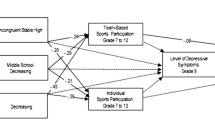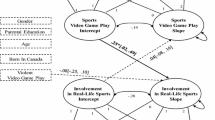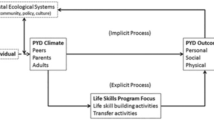Abstract
Youth sport offers physical and psychosocial components that may be beneficial for adolescents’ mental health, but the prospective directionality between sport participation and mental health has not been clearly established. The current study examined longitudinal associations between sport participation (individual and team sport) and mental health indices (depressive symptoms, anxiety symptoms, emotional symptoms, hyperactivity symptoms, conduct problems, peer problems, and prosocial behavior) across adolescence (ages 12–17) in a nationally representative Australian sample of 3956 participants at T1 (Mage = 12.41 years, SD = 0.49; 49% female), 3537 at T2 (Mage = 14.41 years, SD = 0.49; 49% female), and 3089 at T3 (Mage = 16.46 years, SD = 0.51; 49% female). Using random intercept cross-lagged panel modeling, several significant within-person effects were found. Notably, greater participation in team sport prospectively predicted fewer symptoms of depression and anxiety at subsequent timepoints. This study increases the understanding of how sport participation may relate to mental health among adolescents and provides critical evidence to inform policy.

Similar content being viewed by others
Notes
Within the LSAC, items that pertain to involvement in community sport transitioned from parent-reported to child-reported in Wave 6.
Note that the primary findings from the sensitivity analyses conducted using only complete cases did not differ from the models reported in the manuscript, which used full information maximization likelihood to retain all cases and all available information.
References
Ahn, S., & Fedewa, A. L. (2011). A meta-analysis of the relationship between children’s physical activity and mental health. Journal of Pediatric Psychology, 36, 385–397. https://doi.org/10.1093/jpepsy/jsq107.
Altemus, M., Sarvaiya, N., & Epperson, C. N. (2016). Sex differences in anxiety and depression clinical perspectives. Frontiers in Neuroendocrinology, 35, 320–330. https://doi.org/10.1016/j.yfrne.2014.05.004.Sex.
Angold, A., Costello, E. J., Messer, S., Pickles, A., Winder, F., & Silver, D. (1995). Development of a short questionnaire for use in epidemiological studies of depression in children and adolescents. International Journal of Methods in Psychiatric Research, 5, 237–249.
Aubert, S., Barnes, J. D., Abdeta, C., Nader, P. A., Adeniyi, A. F., Tenesaca, D. S. A., Bhawra, J., Brazo-sayavera, J., Chang, C., Nyström, C. D., Demetriou, Y., Draper, C. E., Edwards, L., Emeljanovas, A., Gába, A., Galaviz, K. I., González, S. A., Huang, W. Y., Ibrahim, I. A. E., & Tremblay, M. S. (2018). Global matrix 3.0 physical activity report card grades for children and youth: results and analysis from 49 countries. Journal of Physical Activity and Health, 15, 251–273.
Berry, D., & Willoughby, M. T. (2017). On the practical interpretability of cross-lagged panel models: rethinking a developmental workhorse. Child Development, 88, 1186–1206. https://doi.org/10.1111/cdev.12660.
Bor, W., Dean, A. J., Najman, J. & Hayatbakhsh, R. (2014). Are child and adolescent mental health problems increasing in the 21st century? A systematic review. Australian & New Zealand Journal of Psychiatry, 48, 606–616.
Costello, E. J., Egger, H. & Angold, A. (2005). 10-year research update review: The epidemiology of child and adolescent psychiatric disorders: I. Methods and public health burden. Journal of the American Academy of Child & Adolescent Psychiatry, 44, 972–986.
Curran, P. J., & Bauer, D. J. (2011). The disaggregation of within-person and between-person effects in longitudinal models of change. Annual Review of Psychology, 62, 583–619. https://doi.org/10.1146/annurev.psych.093008.100356.
Eime, R. M., Young, J. A., HarveyJ. T., Charity, M. J. & Payne, W. R. (2013). A systematic review of the psychological and social benefits of participation in sport for children and adolescents: informing development of a conceptual model of health through sport. International Journal of Behavioral Nutrition and Physical Activity, 10, 98. https://doi.org/10.1186/1479-5868-10-98.
Enders, C. K. (2010). Applied missing data analysis. Guilford.
Enders, C. K. (2011). Analyzing longitudinal data with missing values. Rehabilitation Psychology, 56, 267–288. https://doi.org/10.1037/a0025579.
Evans, M. B., Adler, A., MacDonald, D., & Côté, J. (2016). Bullying victimization and perpetration among adolescent sport teammates. Pediatric Exercise Science, 28(2), 296–303. https://doi.org/10.1123/pes.2015-0088.
Goodman, R., Ford, T., Simmons, H., Gatward, R., & Meltzer, H. (2000). Using the Strengths and Difficulties Questionnaire (SDQ) to screen for child psychiatric disorders in a community sample. British Journal of Psychiatry, 177, 534–539.
Graupensperger, S., Benson, A. J., Kilmer, J. R., & Evans, M. B. (2020). Social (un)distancing: teammate interactions, athletic identity, and mental health of student-athletes during the COVID-19 pandemic. Journal of Adolescent Health, 67, 662–670.
Graupensperger, S., Panza, M. J., Budziszewski, R. & Evans, M. B. (2020). Growing into “Us”: Trajectories of social identification with college sport teams predict subjective well-being. Applied Psychology: Health and Well-Being, 12, 787–807.
Haase, A. M. (2011). Physique anxiety and disordered eating correlates in female athletes: differences in team and individual sports. Eating Behaviors, 12, 64–67. https://doi.org/10.1123/jcsp.3.3.218.
Hamaker, E. L., Kuiper, R. M., & Grasman, R. P. P. P. (2015). A critique of the cross-lagged panel model. Psychological Methods, 20, 102–116. https://doi.org/10.1037/a0038889.
Jewett, R., Sabiston, C. M., Brunet, J., O'Loughlin, E. K., Scarapicchia, T. & O’Loughlin, J. (2014). School sport participation during adolescence and mental health in early adulthood. Journal of Adolescent Health, 55, 640–644.
Kessler, R. C., Berglund, P., Demler, O., Jin, R., Merikangas, K. R., & Walters, E. E. (2005). Lifetime prevalence and age-of-onset distributions of DSM-IV disorders in the National Comorbidity Survey replication. Archives of General Psychiatry, 62, 593–602. https://doi.org/10.1001/archpsyc.62.6.593.
Kieling, C., Baker-Henningham, H., Belfer, M., Conti, G., Ertem, I., Omigbodun, O., Rohde, L. A., Srinath, S., Ulkuer, N., & Rahman, A. (2011). Child and adolescent mental health worldwide: evidence for action. The Lancet, 378, 1515–1525. https://doi.org/10.1016/S0140-6736(11)60827-1.
Kiluk, B. D., Weden, S. & Culotta, V. P. (2009). Sport participation and anxiety in children with ADHD. Journal of Attention Disorders, 12, 499–506.
Lawrence, D., Johnson, S., Hafekost, J., Boterhoven De Haan, K., Sawyer, M., Ainley, J., & Al, E. (2015). The mental health of children and adolescents: report on the second Australian Child and Adolescent Survey of mental health and wellbeing. Canberra: Department of Health.
Little, T. D., Jorgensen, T. D., Lang, K. M., & Moore, E. W. G. (2014). On the joys of missing data. Journal of Pediatric Psychology, 39, 151–162. https://doi.org/10.1093/jpepsy/jst048.
Logan, K., Cuff, S. & Sports, O. N. (2019). Organized sports for children, preadolescents, and adolescents. Pediatrics, 143, e20190997. https://doi.org/10.1542/peds.2019-0997.
MacDonald, D. J., Côté, J., Eys, M. & Deakin, J. (2012). Psychometric properties of the youth experience survey with young athletes. Psychology of Sport and Exercise, 13, 332–340.
Meadows, G. N., Prodan, A., Patten, S., Shawyer, F., Francis, S., Enticott, J., Rosenberg, S., Atkinson, J. A., Fossey, E., & Kakuma, R. (2019). Resolving the paradox of increased mental health expenditure and stable prevalence. Australian and New Zealand Journal of Psychiatry, 53, 844–850. https://doi.org/10.1177/0004867419857821.
Merglen, A., Flatz, A., Bélanger, R. E., Michaud, P. A. & Suris, J. C. (2014). Weekly sport practice and adolescent well-being. Archives of Disease in Childhood, 99, 208–210.
Mojtabai, R., Olfson, M., & Han, B. (2016). National trends in the prevalence and treatment of depression in adolescents and young adults. Pediatrics, 138, e20161878 https://doi.org/10.1542/peds.2016-1878.
Muthén, L. K., & Muthén, B. O. (2018). Mplus user’s guide (8th ed.). Muthén & Muthén.
Panza, M., Graupensperger, S., Agans, J., Doré, I., Vella, S., & Evans, B. (2020). Adolescent sport participation and symptoms of anxiety and depression: a systematic review and meta-analysis. Journal of Sport & Exercise Psychology, Ahead of Print https://doi.org/10.1123/jsep.2019-0235.
Pluhar, E., Mccracken, C., Griffith, K. L., Christino, M. A., Sugimoto, D., & Iii, W. P. M. (2019). Team sport athletes may be less likely to suffer anxiety or depression than individual sport athletes. Journal of Sports Science and Medicine, 18, 490–496.
Putukian, M., Kreher, J. B., Coppel, D. B., Glazer, J. L., McKeag, D. B. & White, R. D. (2011). Attention deficit hyperactivity disorder and the athlete: An American Medical Society for Sports Medicine position statement. Clinical Journal of Sport Medicine, 21, 392–400.
Reardon, T., Spence, S. H., Hesse, J., Shakir, A., & Creswell, C. (2018). Identifying children with anxiety disorders using brief versions of the Spence Children’s Anxiety Scale for children, parents, and teachers. Psychological Assessment, 30, 1342–1355. https://doi.org/10.1037/pas0000570.
Rehm, J., & Shield, K. D. (2019). Global burden of disease and the impact of mental and addictive disorders. Current Psychiatry Reports, 21, 10 https://doi.org/10.1007/s11920-019-0997-0.
Sawyer, M. G., Reece, C. E., Sawyer, A. C. P., Hiscock, H., & Lawrence, D. (2019). Adequacy of treatment for child and adolescent mental disorders in Australia: a national study. Australian and New Zealand Journal of Psychiatry, 53, 326–335. https://doi.org/10.1177/0004867418808895.
Schafer, J. L., & Graham, J. W. (2002). Missing data: our view of the state of the art. Psychological Methods, 7, 147–177. https://doi.org/10.1037//1082-989X.7.2.147.
Slater, A., & Tiggemann, M. (2011). Gender differences in adolescent sport participation, teasing, self-objectification and body image concerns. Journal of Adolescence, 34, 455–463. https://doi.org/10.1016/j.adolescence.2010.06.007.
Slominski, L., Sameroff, A., Rosenblum, K., & Kasser, T. I. M. (2011). Longitudinal predictors of adult socioeconomic attainment: the roles of socioeconomic status, academic competence, and mental health. Development and Psychopathology, 23, 315–324. https://doi.org/10.1017/S0954579410000829.
Spence, S. H., Barrett, P. M., & Turner, C. M. (2003). Psychometric properties of the Spence Children’s Anxiety Scale with young adolescents. Journal of Anxiety Disorders, 17, 605–625. https://doi.org/10.1016/S0887-6185(02)00236-0.
van Geelen, S. M., Rydelius, P. A. & Hagquist, C. (2015). Somatic symptoms and psychological concerns in a general adolescent population: Exploring the relevance of DSM-5 somatic symptom disorder. Journal of Psychosomatic Research, 79, 251–258.
Van Roy, B., Veenstra, M., & Clench-Aas, J. (2008). Construct validity of the five-factor Strengths and Difficulties Questionnaire (SDQ) in pre-, early, and late adolescence. Journal of Child Psychology and Psychiatry, and Allied Disciplines, 49, 1304–1312. https://doi.org/10.1111/j.1469-7610.2008.01942.x.
Vella, S. A. (2019). Mental health and organized youth sport. Kinesiology Review, 8, 229–236. https://doi.org/10.1123/kr.2019-0025.
Vella, S. A., Cliff, D. P., Magee, C. A. & Okely, A. D. (2014). Sports participation and parent-reported health-related quality of life in children: Longitudinal associations. Journal of Pediatrics, 164, 1469–1474.
Vella, S. A., & Swann, C. (2020). Time for mental healthcare guidelines for recreational sports: A call to action. British Journal of Sports Medicine, bjsports-2019-101591. https://doi.org/10.1136/bjsports-2019-101591.
Vella, S. A., Swann, C., Allen, M. S., Schweickle, M. J., & Magee, C. A. (2017). Bidirectional associations between sport involvement and mental health in adolescence. Medicine and Science in Sports and Exercise, 49, 687–694. https://doi.org/10.1249/MSS.0000000000001142.
Westerhof, G. J., & Keyes, C. L. M. (2010). Mental illness and mental health: the two continua model across the lifespan. Journal of Adult Development, 17, 110–119. https://doi.org/10.1007/s10804-009-9082-y.
WHO. (2014). Mental health. World Health Organization. Retrieved from http://www.Who.Int/Features/Factfiles/Mental_health/En/.
Authors’ Contributions
S.G. conceived the study, performed the data analyses and coordinated the first draft of the manuscript and its submission; J.S. organized the data and helped conceive the study, assisted with the interpretation of the results, and participated in manuscript drafting; S.V. contributed to study conception, the interpretation of the findings and manuscript drafting. All authors read and approved the final manuscript.
Funding
S.G. is supported by a training fellowship from the National Institutes of Health (T32AA007455). The content of this manuscript is solely the responsibility of the authors and does not necessarily represent the official views of the NIH.
Data Sharing and Declaration
The data that support the findings of this study are available from the Longitudinal Study of Australian Children, but restrictions apply to the availability of these data, which were used under license for the current study, and so are not publicly available without application procedures.
Author information
Authors and Affiliations
Corresponding author
Ethics declarations
Conflict of Interest
The authors declare no competing interests.
Ethical Approval
Ethical standards were adhered to in all aspects of the Longitudinal Study of Australian Children. For more information on specific procedures and ethical clearance, please visit: https://growingupinaustralia.gov.au/.
Informed Consent
All participants in the Longitudinal Study of Australian Children provided informed consent prior to participating.
Additional information
Publisher’s note Springer Nature remains neutral with regard to jurisdictional claims in published maps and institutional affiliations.
Supplementary Information
Rights and permissions
About this article
Cite this article
Graupensperger, S., Sutcliffe, J. & Vella, S.A. Prospective Associations between Sport Participation and Indices of Mental Health across Adolescence. J Youth Adolescence 50, 1450–1463 (2021). https://doi.org/10.1007/s10964-021-01416-0
Received:
Accepted:
Published:
Issue Date:
DOI: https://doi.org/10.1007/s10964-021-01416-0




